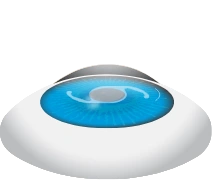
Refractive Lens Exchange
Patients seeking Refractive Lens Exchange (RLE) in Colorado Springs choose Skyline LASIK because we offer the latest advancements in lens technology and equipment. Our elite surgeons are dedicated to offering a personalized treatment that is custom-tailored just for you.
What is Refractive Lens Exchange (RLE)?
As Colorado’s leading refractive surgery center, we specialize in RLE, an optimal vision correction solution ideal for individuals over 40 who are beginning to experience presbyopia—the common age-related challenge of reading up close. RLE stands out as it not only corrects presbyopia, thereby reducing the dependency on reading glasses, but also effectively treats nearsightedness, farsightedness, and astigmatism. This makes RLE a versatile option for mature patients seeking to enhance vision across various distances, unlike LASIK, which typically addresses vision at a single distance.
During RLE surgery at Skyline LASIK, your natural lens is removed and replaced with an artificial implant called an intraocular lens (IOL) to achieve clear
Trusted Source
Refractive Lens Exchange
Cleveland Clinic
Go to Source
vision.
We offer many different advanced IOL options to help you achieve your vision goals. If you’re ready to invest in long-term clear vision, contact us today to find out if RLE is right for you.

Good Candidates for RLE:
- Are in their 40s & 50s
- Have noticed age-related near vision loss (Presbyopia)
- Suffer from nearsightedness, farsightedness, or astigmatism
- Remove their glasses to read
- Wear either progressive or bifocal glasses
- Have not been diagnosed with visually significant cataracts
- Are ready to invest in clear vision for life
To see if you are a good candidate for RLE surgery, start by taking our 60-second RLE Candidacy Quiz.
The Value of RLE
Patients often compare prices between vision correction procedures, assuming that the procedure with the lowest price is the best one for them. This is not always the case, especially when you account for long-term vision costs.
For example, consider the price comparison between LASIK and RLE. Yes, LASIK does come at a lower cost than RLE. However, what patients may not realize is that even after LASIK, they are likely to develop cataracts at a later age. Cataracts are a natural part of the aging process that happen to most people. At first, it’s possible to get around cloudy vision from cataracts by changing prescriptions. Eventually, the cloudy lens of the eye will need to be surgically replaced during cataract surgery, a procedure that is identical to RLE.
Patients who choose to undergo RLE to correct their vision at an earlier age will never develop cataracts because the natural lens of the eye has already been replaced. Patients who have LASIK, however, are still very likely to pay for cataract surgery in the future. This means that LASIK patients will often need to pay for two vision correction procedures during their lifetime, while RLE is just a single, one-time expense.
Choosing an Intraocular Lens (IOL) for RLE Surgery
When considering RLE surgery, selecting the right intraocular lens (IOL) is crucial for achieving your desired vision outcomes. IOLs are artificial lenses that replace the eye’s natural lens, and they come in various types, each designed to address different visual impairments. It’s important for patients to be clear about the activities they typically engage in and whether they are more interested in correcting near vision, distance vision, or a vision at multiple ranges. The three primary categories of IOLs used for RLE surgery are:
Monofocal and Monofocal Toric IOLs
Monofocal and Monofocal Toric IOLs are designed to provide clear vision at one particular distance. Patients who opt for this type of lens typically have it set for distance in both eyes which means glasses will be needed for intermediate and near visuals. Since, glasses will be needed post surgery these IOLs are not used as often during RLE surgery.
Premium IOLs
Premium IOLs are primarily used during RLE surgery because they provide the most comprehensive visual freedom after age 40. These advanced lenses are engineered to correct more than one range of vision unlike the Monofocal IOLs. Within this category, you can find:
- Trifocal IOLs focus light at 3 different focal points in the back of the eye providing distance, intermediate and near vision while minimizing your dependence on glasses for most daily activities, including reading small print. We use the Clareon® PanOptix® IOL, an advanced trifocal IOL that uses ENLIGHTEN® technology designed to optimize intermediate vision without compromising the quality of vision at both distance and near for our
Trusted Source Effectiveness and Safety of the Clareon Monofocal Intraocular Lens: Outcomes from a 12-Month Single-Arm Clinical Study in a Large Sample Walters, TR, Fakadej, A Go to Source patients.
- Extended Depth of Focus (EDOF) IOLs offer a continuous range of high-quality vision by extending the focusable range. This option aims to provide a smoother visual transition without the same nighttime visual disturbances often seen with multifocal or trifocal IOLs. EDOF IOLs provide patients with distance, intermediate and functional near vision with the occasional use of readers.
Each IOL type offers unique benefits and potential trade-offs. During your consultation, your surgeon will discuss your lifestyle, vision goals, and the specifics of each IOL type to help you choose the most suitable lens for your RLE surgery.
Preparing For RLE
Preparation for RLE surgery encompasses several steps to ensure safety and optimal outcomes. Initial preparations involve a thorough eye exam, choosing an appropriate intraocular lens (IOL), and sharing your medical history with your surgeon. In the week leading up to the surgery, prepare by picking up your prescribed medicated drops from the pharmacy, and arrange transportation to and from the surgery center. The day before surgery you will begin using your prescribed medicated eye drops. On the day of the surgery, you are required to not eat or drink 8 hours prior to surgery and abstain from wearing makeup or jewelry to the surgery center.
What to Expect During RLE
RLE surgery is performed as an outpatient procedure at an Ambulatory Surgical Center. Surgery is performed using conscious sedation that will help you relax and feel comfortable. The surgeon will start by using our Catalys™ Precision Laser to make a small incision at the edge of your cornea and a small incision in the capsule around your natural lens while breaking up your lens so the surgeon can then remove it completely. Once your lens is removed your surgeon will use our ORA System® to analyze the refractive power of your eye allowing adjustments to be made in choosing the optimal power for your IOL. The surgeon will then insert an IOL positioning it within the capsule inside your eye.
- Numbing Drops
- Clear Lens is Removed
- IOL Implanted in Place
Recovery After RLE Surgery
Recovery from RLE typically involves using prescribed eye drops to prevent infection and control inflammation. Patients often notice an improvement in their vision within a day or two, but full recovery and stabilization of vision might take several weeks. Most people can return to their usual activities within a week.
RLE surgery takes roughly 5-10 minutes to perform and only one eye is completed at a time. You will begin seeing right away, but full vision results are achieved once both eyes have been treated and healed.

Why Choose Skyline LASIK for RLE
Advancements in lens technology and equipment are used for precision and accuracy that enables the achievement of high-quality vision at distance, intermediate and near visuals as well as:
- Board Certified Ophthalmologists that specialize in refractive surgery
- The use of our Advanced technology ORA System® & Catalys™ Precision Laser
- Premium IOLs because quality matters
- Eliminates the need for cataract
Trusted Source Refractive lens exchange in modern practice: when and when not to do it? Eye and Vision Go to Source surgery, and prevents future cataracts.
- Can be a better solution than LASIK for patients with presbyopia or more extensive degrees of hyperopia or
Trusted Source A Review of Refractive Lens Exchange Review of Ophthalmology Go to Source myopia.

Cost of RLE
Our valued patients often say that the gift of clear vision is truly invaluable which is why they choose RLE at Skyline LASIK. Beyond the flexibility and freedom that RLE surgery provides, it can also be a wise financial decision. Cumulative costs of continually purchasing glasses and contacts throughout your lifetime adds up, and offers just a short-term fix. In contrast, RLE offers a lasting solution that could save you thousands over the years. Explore our flexible and convenient payment options.
Ready to See The World Clearly With RLE?
If you’re ready to stop relying on glasses and contacts, schedule a consultation for RLE in Colorado Springs with our team!
FAQs About RLE
How is RLE different from cataract surgery?
The procedures are identical; both involve replacing the natural lens with an artificial one and help minimize the need for corrective eyewear. The primary difference is the reason for surgery: RLE is an elective procedure performed to correct refractive errors to improve near and far vision and minimize the need for corrective eyewear, while cataract surgery is medically necessary and performed to replace a lens that has become cloudy due to cataract formation.
What types of IOLs are available?
There are various types of IOLs available, including monofocal, trifocal, and extended depth of focus lenses, each designed to provide different visual outcomes. See our choosing an intraocular lens section above.
Are there risks associated with RLE?
Complications are rare, however like any surgery, RLE has
Trusted Source
The Refractive Lens Exchange Debate
The
American Academy of Ophthalmology
Go to Source
risks
and potential complications. These include infection, inflammation, retinal detachment, dry eye, and issues with the positioning of the IOL, among others. It’s essential to discuss these risks thoroughly with your surgeon and to ensure that all your questions and concerns are addressed.
How long do the results from RLE last?
The artificial lenses used in RLE are designed to last a lifetime. They do not age, deteriorate, or need to be replaced under normal circumstances. However, some patients may experience posterior capsule opacification (PCO) which presents as a blurry film over the field of vision. This is common, but can be easily treated with a quick in-office laser treatment.
Will I still need to wear eyeglasses after RLE?
The goal of RLE is to minimize dependence on glasses. Many patients find they can do most of their activities without glasses after RLE, but some might still need to wear glasses for specific tasks like reading or driving, depending on the type of IOL implanted and their visual needs.
Is RLE covered by insurance?
Since RLE is considered an elective procedure for refractive error correction, it is not covered by medical insurance. It’s essential to discuss cost, payment options, and any available financing plans during your consultation.
Can RLE be performed if I have had previous eye surgery?
The short answer is yes! It depends on the type of previous surgery and your current eye health. In general, previous eye surgery can impact which IOL option is best suited for the patient. Patients who have had prior eye surgeries, such as LASIK, might still be candidates for RLE, but it’s crucial to have a detailed examination and discussion about vision problems with your eye doctor to determine your suitability.
1 Cleveland Clinic. Refractive Lens Exchange. Available: https://my.clevelandclinic.org/health/treatments/24840-refractive-lens-exchange. Accessed October 3, 2023.
2 Lehmann, R., Maxwell, A., Lubeck, DM, Fong, R., Walters, TR, Fakadej, A. Effectiveness and Safety of the Clareon Monofocal Intraocular Lens: Outcomes from a 12-Month Single-Arm Clinical Study in a Large Sample. Clin Ophthalmol. 2021;15:1647-1657. Published Apr 20, 2021.
3 Eye and Vision. Refractive lens exchange in modern practice: when and when not to do it? Available: https://www.ncbi.nlm.nih.gov/pmc/articles/PMC4655463/. Accessed October 3, 2023.
4 Review of Ophthalmology. A Review of Refractive Lens Exchange. Available: https://www.reviewofophthalmology.com/article/a-review-of-refractive-lens-exchange. Accessed October 3, 2023.
5 American Academy of Ophthalmology. The Refractive Lens Exchange Debate. Available: https://www.aao.org/eyenet/article/refractive-lens-exchange-debate. Accessed October 3, 2023.
The doctors at Skyline LASIK have authored or reviewed and approved this content. | Page Updated:



